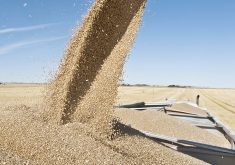Statistics Canada’s December stocks report confirms that canola supplies will remain tight for the rest of the 2010-11 marketing campaign.
The agency said 8.24 million tonnes of the oilseed remained in the hands of farmers and grain companies as of Dec. 31, which is 13 percent lower than the same time in the 2009-10 crop year.
Errol Anderson, analyst with Pro- Market Wire, said the report helped boost prices last week in an effort to ration demand because the industry can’t sustain the current pace of exports and domestic crush.
Read Also

Soybean market still figuring out implications of China-U.S. pact
Soybean futures had a muted reaction to the U.S. trade deal with China as the market tries to figure out the nuances of the deal.
Total supply of the crop for 2010- 11 is 14.24 million tonnes, which is almost identical to the 14.21 million tonnes of canola available in 2009-10.
Exports and domestic use totalled 6.52 million tonnes in the first six months of 2010-11, which is 980,000 tonnes ahead of the previous year’s pace.
Demand is unlikely to sustain that blistering pace because it would draw down ending stocks to an unsustainable level.
However, Anderson said demand in the last half of 2010-11 will continue to exceed the pace set in 2009-10 because of increased domestic crush capacity and stronger export prospects due to lower than expected Chinese oilseed production.
“China could become a very active buyer of Canadian canola in the last half,” he said.
Marlene Boersch, managing partner of Mercantile Consulting Venture, agreed prices will increase.
“The gains forward to be made are probably in the new crop because we’ll go into the new crop year with next to no carryout, so the scenario has changed a little bit,” she said.
New crop prices have already narrowed the gap with old crop prices.
Boersch said now is a good time for farmers to forward price some of next year’s crop. She suggested locking in an amount equal to their estimated fall cash flow needs.
“If I were a farmer, I think that would be a very good strategy right now,” she said.
“These prices are very good. Certainly they lock in an excellent return per acre.”
Anderson advised farmers to lock in 20 to 30 percent of their production in deferred delivery contracts, which could surpass $14 per bushel.
“These are rich numbers that they can get off the combine,” he said.
Growers should also consider taking the next step by purchasing put options, which have no delivery or production obligations.
Anderson said it’s possible markets could go into “panic mode” if carryout appeared to be lower than 500,000 tonnes, which would cause a major price spike.
All the elements are in place for a volatile market: a general inflationary commodity market, growing interest from investment funds and the looming acreage battle.
Markets could turn into an unpredictable “cornered, wild animal,” he added.
Anderson said holding out for the apex of the market is a dangerous tactic because the downside could become vicious if everybody sells at once.
“I wouldn’t wait on this thing.”















